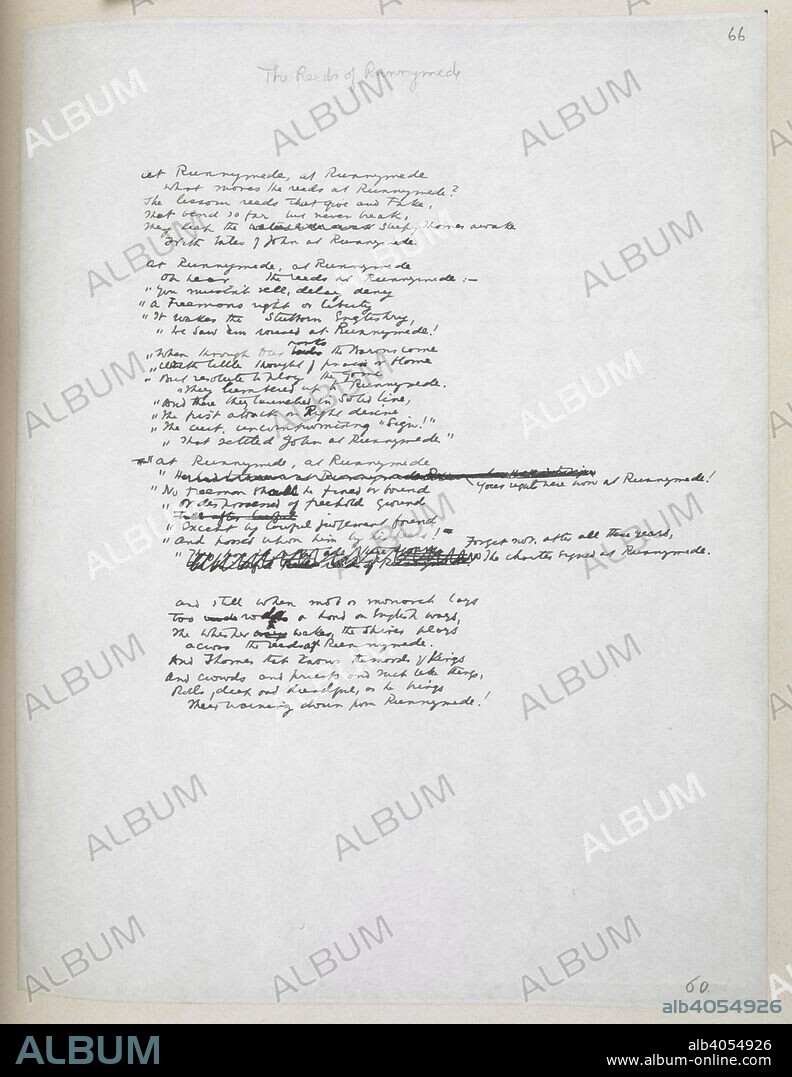alb4054926
‘At Runnymede, at Runnymede / What moves the reeds at Runnymede?’ So begins this poem by Rudyard Kipling (d. 1936), first published in 1911. ‘The Reeds of Runnymede’ was commissioned to accompany a children’s history of England, written by the Oxford academic, C. R. L. Fletcher (d. 1934), to which Kipling contributed twenty-three poems. The book itself received a mixed reaction, on account of Fletcher’s racial prejudices. For instance, Fletcher denigrated the native people of Australia as ‘a few miserable blacks, who could hardly use even bows and arrows’, and he lamented the impact of the abolition of slavery on the prosperity of the West Indies. A History of England was venerated by some, but it was condemned by the Manchester Guardian as a pernicious influence on the minds of children, and the volume was banned in parts of the British Empire. Kipling’s poem, seen here in the author’s draft, is uncontentious. The author imagines that the reeds in the Runnymede water meadow are witnesses to the meeting between King John and the barons, and he suggests that their rustling provides a warning to monarchs who dare to disregard their subjects. Kipling’s handwriting is crabbed, and some of his original words were altered when the poem was being prepared for publication. For example, the opening lines of the manuscript version read, ‘What moves the reeds at Runnymede’, reproduced in print as ‘What say the reeds’. The penultimate stanza of the poem is rewritten extensively in the manuscript, with this being Kipling’s final draft: At Runnymede, at Runnymede, Your rights were won at Runnymede! No freeman shall be fined or bound, Or dispossessed of freehold ground, Except by lawful judgement found And passed upon him by his peers! Forget not, after all these years, The charter signed at Runnymede. Autograph manuscript of Rudyard Kipling’s “Reeds at Runnymede†(c. 1911). c.1911. Source: Add. 44841 f.66.

|
Añadir a otro lightbox |
|
Añadir a otro lightbox |



¿Ya tienes cuenta? Iniciar sesión
¿No tienes cuenta? Regístrate
Compra esta imagen.
Selecciona el uso:

Autor:
Descripción:
Ver traducción automática
‘At Runnymede, at Runnymede / What moves the reeds at Runnymede?’ So begins this poem by Rudyard Kipling (d. 1936), first published in 1911. ‘The Reeds of Runnymede’ was commissioned to accompany a children’s history of England, written by the Oxford academic, C. R. L. Fletcher (d. 1934), to which Kipling contributed twenty-three poems. The book itself received a mixed reaction, on account of Fletcher’s racial prejudices. For instance, Fletcher denigrated the native people of Australia as ‘a few miserable blacks, who could hardly use even bows and arrows’, and he lamented the impact of the abolition of slavery on the prosperity of the West Indies. A History of England was venerated by some, but it was condemned by the Manchester Guardian as a pernicious influence on the minds of children, and the volume was banned in parts of the British Empire. Kipling’s poem, seen here in the author’s draft, is uncontentious. The author imagines that the reeds in the Runnymede water meadow are witnesses to the meeting between King John and the barons, and he suggests that their rustling provides a warning to monarchs who dare to disregard their subjects. Kipling’s handwriting is crabbed, and some of his original words were altered when the poem was being prepared for publication. For example, the opening lines of the manuscript version read, ‘What moves the reeds at Runnymede’, reproduced in print as ‘What say the reeds’. The penultimate stanza of the poem is rewritten extensively in the manuscript, with this being Kipling’s final draft: At Runnymede, at Runnymede, Your rights were won at Runnymede! No freeman shall be fined or bound, Or dispossessed of freehold ground, Except by lawful judgement found And passed upon him by his peers! Forget not, after all these years, The charter signed at Runnymede. Autograph manuscript of Rudyard Kipling’s “Reeds at Runnymede†(c. 1911). c.1911. Source: Add. 44841 f.66.
Crédito:
Album / British Library
Autorizaciones:
Tamaño imagen:
6445 x 8335 px | 153.7 MB
Tamaño impresión:
54.6 x 70.6 cm | 21.5 x 27.8 in (300 dpi)
Palabras clave:
ACONTECIMIENTO • DOCUMENTO • KIPLING, RUDYARD • LIBERTAD • LIRICO • MANUSCRITO • POEMA • POEMAS • POESIA • S. XX • SIGLO XX
 Pinterest
Pinterest Twitter
Twitter Facebook
Facebook Copiar enlace
Copiar enlace Email
Email
